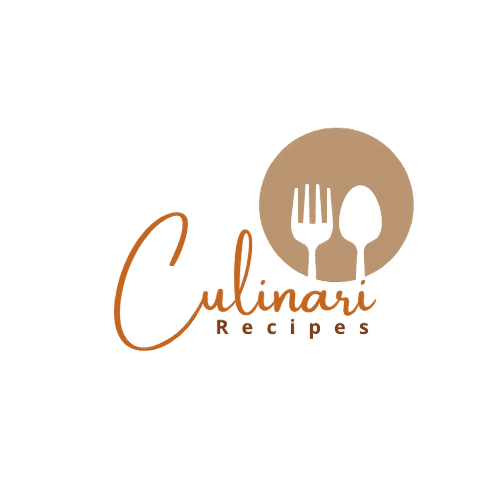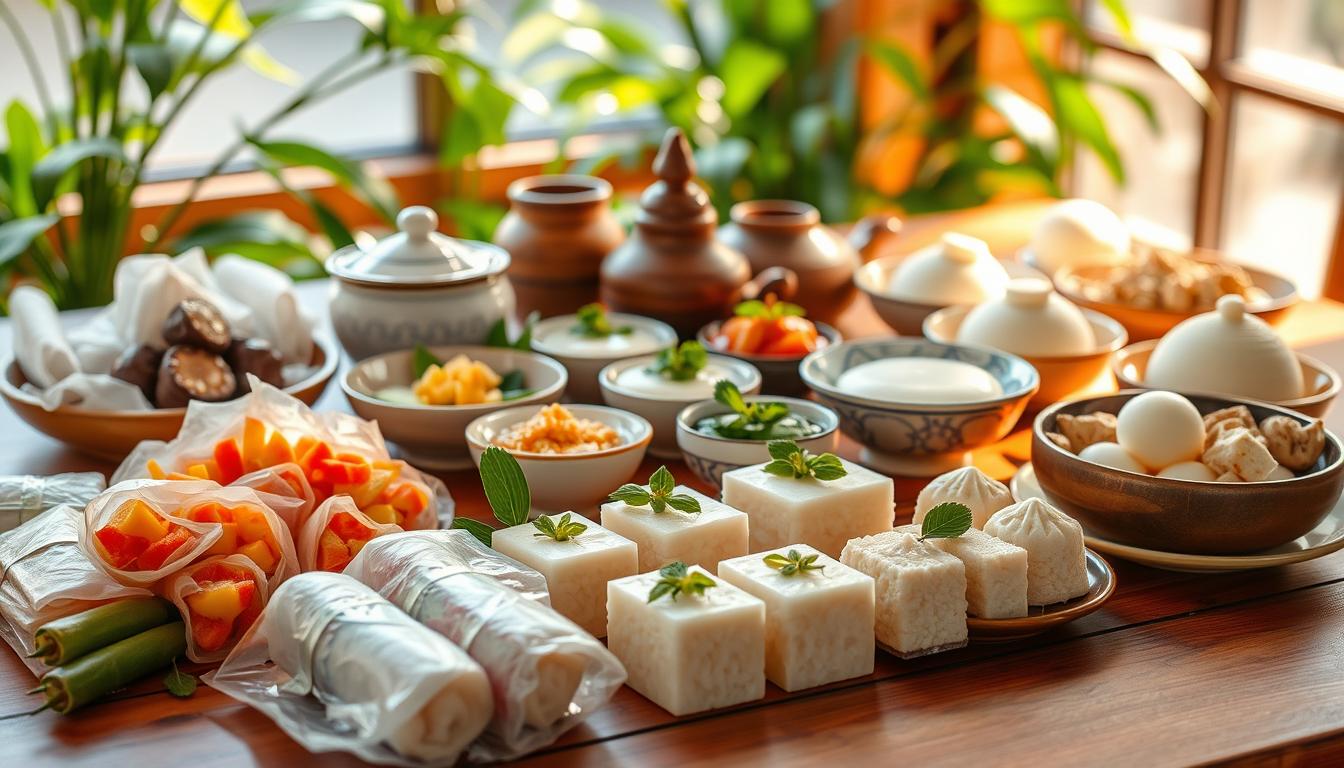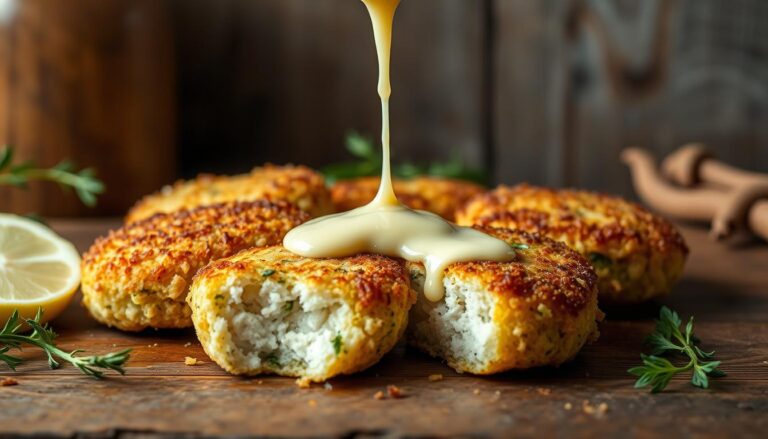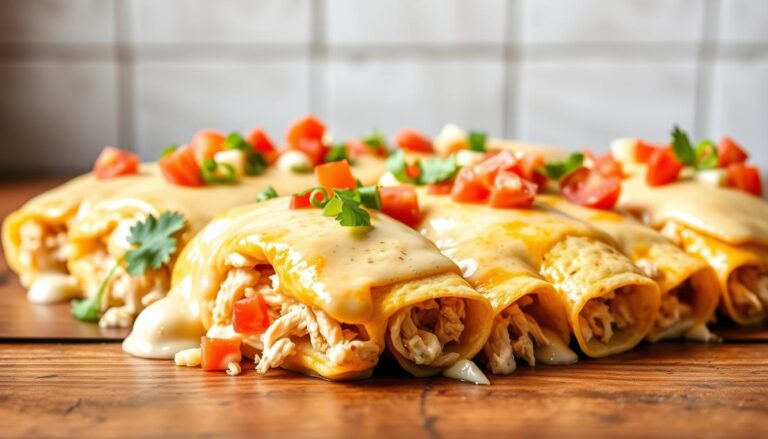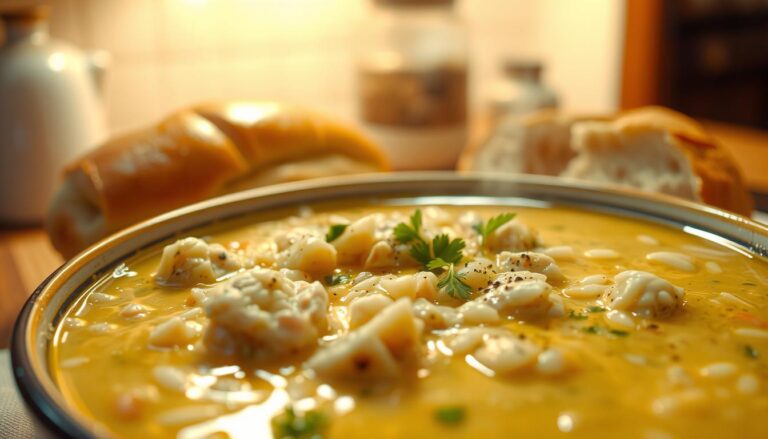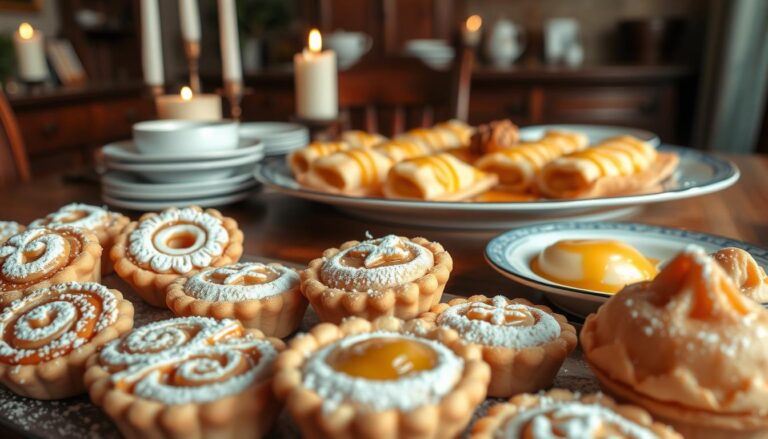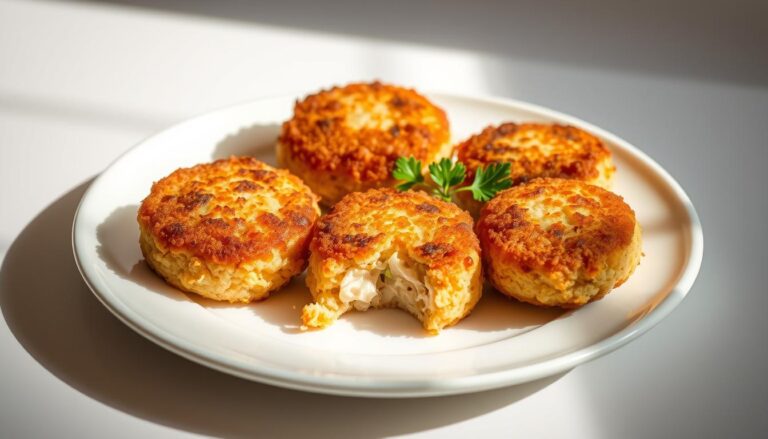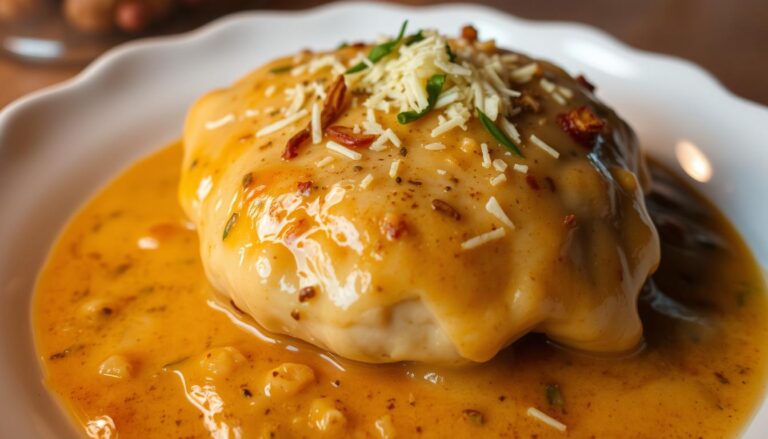Explore the Flavors of Vietnamese Desserts
You might be surprised to learn that Vietnamese cuisine offers a diverse and vibrant array of authentic sweets. These are both delicious and culturally significant.
From sweet soups to sticky rice cakes, Vietnamese desserts are a treasure trove of flavors and textures. They reflect the country’s rich cultural heritage and culinary creativity.
As you explore Vietnamese desserts, you’ll find a unique blend of traditional and modern flavors. These flavors are sure to tantalize your taste buds.
Table of Contents
The Diverse World of Vietnamese Desserts
Vietnamese desserts offer a unique taste of Vietnam. They blend different cultures like Chinese, French, and Cambodian, yet keep a distinct Vietnamese touch. This is thanks to local ingredients like glutinous rice, coconut milk, and pandan leaves.
A Brief History of Vietnamese Sweets
Vietnamese desserts have a long history. The arrival of Buddhism from India introduced new ingredients and cooking methods. These influences mixed with local traditions to create unique sweets.
Cultural Significance of Desserts in Vietnam
Desserts in Vietnam are more than just sweet treats. They carry deep cultural meaning. Popular Vietnamese treats are enjoyed at big events like Tet and weddings. They bring messages of good luck, prosperity, and unity.
Bánh Chưng, a traditional dessert, is a key part of Tet celebrations. It honors the ancestors and shows gratitude.
Essential Ingredients in Vietnamese Desserts
To understand Vietnamese desserts, it’s crucial to explore the essential ingredients that make them unique. Vietnamese sweets are known for their diverse flavors and textures. These are largely attributed to specific ingredients.
Glutinous Rice and Rice Flour
Glutinous rice and rice flour are staples in Vietnamese desserts. Glutinous rice, also known as sticky rice, is used in various traditional desserts. It has a unique texture. Rice flour is used to create the structure in many Vietnamese cakes and pastries.
Coconut Milk and Coconut Cream
Coconut milk and coconut cream are widely used in Vietnamese desserts. They add richness and a distinct flavor. They are key components in desserts like Chè, a popular Vietnamese sweet soup.
Pandan Leaves and Other Flavorings
Pandan leaves are a crucial flavoring in many Vietnamese desserts. They provide a unique aroma and taste. Other flavorings like vanilla, sesame seeds, and various fruits are also commonly used. They enhance the flavor profile of Vietnamese sweets.
| Ingredient | Usage |
|---|---|
| Glutinous Rice | Bánh Chưng, Xôi |
| Coconut Milk | Chè, Bánh Béo |
| Pandan Leaves | Bánh Flan, Chè Ba Màu |
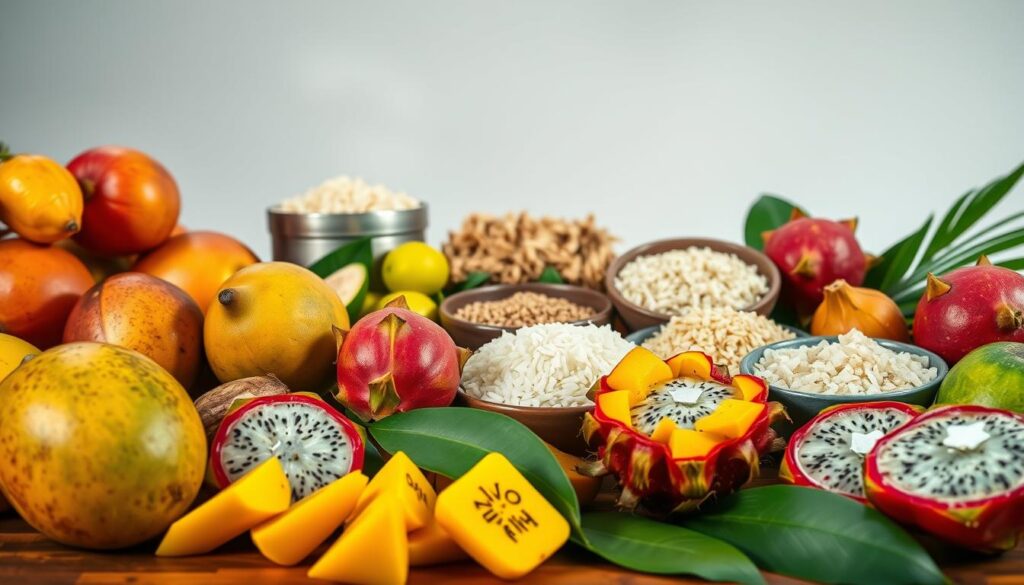
Popular Rice-Based Vietnamese Desserts
Vietnamese rice-based desserts are a sweet treat that shows off the country’s rich food culture. These desserts are a big part of Vietnamese food and are enjoyed at special times and family events.
Chè Trôi Nước (Glutinous Rice Balls)
Chè trôi nước is a traditional Vietnamese dessert. It has glutinous rice balls in a sweet ginger broth. The rice balls are filled with mung bean paste, making the dish even sweeter. It’s a favorite at weddings and holidays.
Bánh Chưng (Sticky Rice Cake)
Bánh chưng is a traditional Vietnamese sticky rice cake. It’s eaten during the Lunar New Year (Tết). Made from glutinous rice, mung beans, and pork, it’s wrapped in banana leaves. Making bánh chưng is a big deal, needing lots of care and knowledge.
Xôi (Sticky Rice Desserts)
Xôi, or sticky rice, is a beloved Vietnamese dessert. It can be sweet or savory. Sweet xôi is flavored with coconut milk, mung beans, or durian. It’s great for any meal, from breakfast to dessert.
| Dessert | Main Ingredients | Occasion |
|---|---|---|
| Chè Trôi Nước | Glutinous rice, mung bean paste, ginger | Special occasions, holidays |
| Bánh Chưng | Glutinous rice, mung beans, pork | Lunar New Year (Tết) |
| Xôi | Glutinous rice, coconut milk, various flavorings | Anytime, breakfast to dessert |
Refreshing Chè Varieties
Chè is a traditional Vietnamese dessert loved for its variety of flavors and textures. It’s a favorite in Vietnamese cuisine, perfect for hot days or any time. It offers refreshing options that delight your taste buds.
Chè Ba Màu (Three-Color Dessert)
Chè ba màu, or three-color dessert, is stunning and delicious. It has three layers: yellow mung bean, green jelly, and white beans or coconut milk. This dessert is a treat for both your taste and eyes, making it great for special occasions.
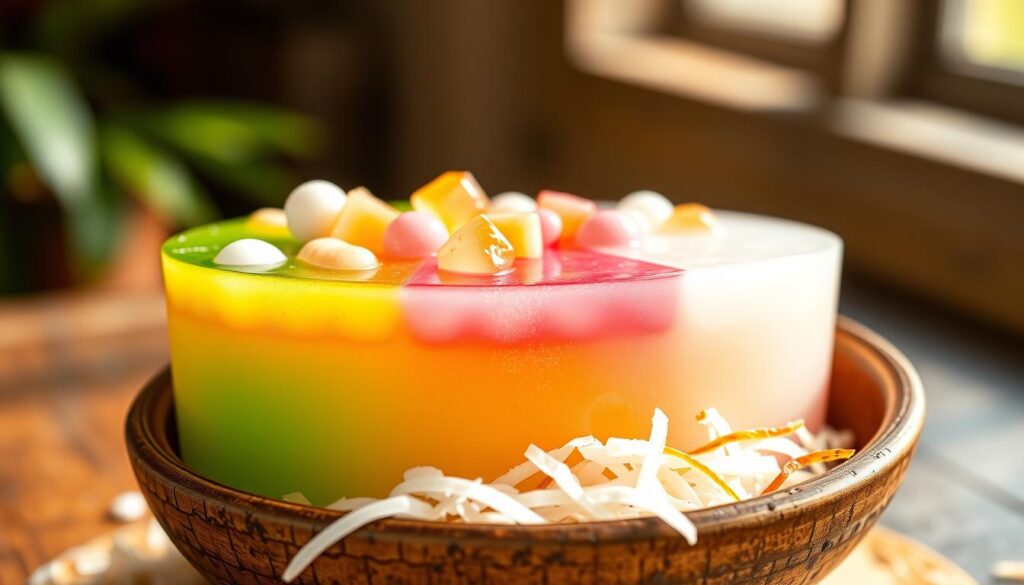
Chè Chuối (Banana Chè)
Chè chuối, or banana chè, is a comforting dessert. It’s made with bananas, coconut milk, and tapioca pearls or jelly. The bananas cook in a sweet coconut milk broth, creating a warm treat perfect for cooler days.
Chè Đậu Xanh (Mung Bean Pudding)
Chè đậu xanh, or mung bean pudding, is a favorite chè variety. It’s made with mung beans, coconut milk, and sugar. The mung beans are cooked until soft, then blended with coconut milk for a creamy pudding.
| Chè Variety | Main Ingredients | Description |
|---|---|---|
| Chè Ba Màu | Mung bean, jelly, coconut milk | Three-layered dessert with distinct colors and flavors |
| Chè Chuối | Bananas, coconut milk, tapioca pearls | Creamy banana dessert with a warm, comforting broth |
| Chè Đậu Xanh | Mung beans, coconut milk, sugar | Nourishing mung bean pudding with a creamy texture |
These refreshing chè varieties show the diversity and richness of Vietnamese desserts. They offer something for every palate and preference. Whether you want something cool and creamy or warm and comforting, Vietnamese chè will satisfy your sweet tooth.
Delicious Vietnamese Cakes and Pastries
Vietnamese cakes and pastries show the country’s rich food culture. They are tasty and carry deep cultural meaning. You can taste the variety of Vietnamese sweets through their cakes and pastries. These often use local ingredients like coconut milk and pandan.
Bánh Bò (Steamed Rice Cake)
Bánh bò is a traditional Vietnamese steamed rice cake. It’s known for its soft texture and gentle sweetness. Made from rice flour, water, and sugar, it’s flavored with pandan leaves for a special aroma. Enjoy bánh bò alone or with coffee or tea.
Bánh Cam (Sesame Balls)
Bánh cam, or sesame balls, are crispy fried dough balls. They’re coated in sesame seeds and filled with sweet mung bean paste. These treats are loved in Vietnam for their crunchy outside and soft inside. They’re great as a dessert or snack, perfect with Vietnamese coffee.
Bánh Pía (Durian Cake)
Bánh pía, also known as durian cake, comes from Sóc Trăng province. It’s a rich pastry with a flaky crust. Inside, it has durian, mung bean paste, and egg yolks for a rich flavor. Try bánh pía at a local Vietnamese bakery for a unique taste.
| Dessert | Main Ingredients | Description |
|---|---|---|
| Bánh Bò | Rice flour, water, sugar, pandan leaves | Steamed rice cake with spongy texture and subtle sweetness |
| Bánh Cam | Dough, sesame seeds, mung bean paste | Crispy fried sesame balls filled with sweet mung bean paste |
| Bánh Pía | Durian, mung bean paste, egg yolks, pastry crust | Flaky pastry filled with durian and mung bean paste mixture |
Cold and Refreshing Vietnamese Desserts
In the hot weather, Vietnamese cold desserts are a great way to cool down. They not only cool you off but also show the variety and richness of Vietnamese food.
Chè Thái (Thai-Inspired Dessert Soup)
Chè Thái, or Thai-inspired dessert soup, is loved in Vietnam. It has colorful fruits, beans, and jellies in a sweet coconut milk broth. The mix of textures and flavors makes it a refreshing treat. To make it, you cook the ingredients separately and then mix them in a chilled coconut milk broth.
Sinh Tố (Vietnamese Smoothies)
Sinh Tố, Vietnamese smoothies, are blended drinks with fruits, yogurt, or milk. Popular flavors include mango, banana, and dragon fruit. They are tasty and healthy, making them great for hot days. You can change the sweetness and creaminess to your liking.
Sữa Chua Nếp Cẩm (Black Sticky Rice Yogurt)
Sữa Chua Nếp Cẩm, or black sticky rice yogurt, is a unique dessert. It has black sticky rice cooked with coconut milk served over yogurt. The creamy yogurt and sweet, chewy rice make a great contrast. This dessert is both nourishing and refreshing, perfect for warm weather.
| Dessert | Main Ingredients | Texture/Flavor |
|---|---|---|
| Chè Thái | Fruits, beans, jellies, coconut milk | Colorful, varied textures, sweet |
| Sinh Tố | Fruits, yogurt/milk | Smooth, creamy, fruity |
| Sữa Chua Nếp Cẩm | Black sticky rice, coconut milk, yogurt | Creamy, chewy, sweet |
French-Influenced Vietnamese Desserts
Vietnamese desserts have a rich history, thanks to French influence. The French brought new dessert styles to Vietnam. These styles mixed with local flavors, creating unique treats.
These desserts show Vietnam’s cultural diversity. They also highlight Vietnamese cuisine’s adaptability.
Bánh Flan
Bánh Flan, or Vietnamese Crème Caramel, is a French-inspired favorite. It has a creamy custard base topped with caramelized sugar. This dessert is a staple in Vietnamese shops.
The French introduced crème caramel, which Vietnamese people adapted. It’s now a best Vietnamese sweet. You can find Bánh Flan in many Vietnamese cafes and bakeries, often with a coffee or coconut milk twist.
Bánh Su Kem
Bánh Su Kem, or Vietnamese Cream Puffs, show French patisserie’s influence. These crispy pastries are filled with a sweet, creamy filling. They’re loved by locals and tourists.
The French origin of cream puffs has been adapted to Vietnamese tastes. Bánh Su Kem is a beloved treat. You can enjoy these authentic Vietnamese sweets in many Vietnamese bakeries, often topped with chocolate or caramel.
Regional Specialties Across Vietnam
Vietnamese desserts vary greatly from north to south. Each region has its own unique flavors and traditions. Exploring these sweets, you’ll find that every area has its own special desserts.
Northern Vietnamese Desserts
In the north, desserts often use glutinous rice and mung beans. Chè Trôi Nước, or glutinous rice balls, are a favorite in winter. They’re served in warm ginger syrup, offering cozy flavors.
Central Vietnamese Desserts
Central desserts are known for their bold tastes and bright colors. Bánh Xèo, a crispy rice flour pancake, is filled with sweet ingredients like coconut or mung bean. These desserts highlight the region’s rich food history, using fresh ingredients and detailed preparation.
Southern Vietnamese Desserts
Southern desserts often include tropical fruits and coconut milk. This makes them rich and creamy. Try making Vietnamese dessert recipes at home, like Sữa Chua Nếp Cẩm, a black sticky rice yogurt dessert. The south’s desserts are known for their fresh coconut and fragrant pandan leaves.
| Region | Popular Desserts | Key Ingredients |
|---|---|---|
| Northern | Chè Trôi Nước, Bánh Chưng | Glutinous rice, mung beans |
| Central | Bánh Xèo, Bánh Bèo | Rice flour, coconut, fresh herbs |
| Southern | Sữa Chua Nếp Cẩm, Chè Ba Màu | Coconut milk, tropical fruits, pandan leaves |
Where to Find Authentic Vietnamese Desserts in the US
Vietnamese communities across the US have many authentic dessert shops and restaurants. If you’re craving traditional Vietnamese sweets, you can find them in these communities.
Vietnamese Bakeries and Dessert Shops
Many Vietnamese bakeries and dessert shops offer a wide range of authentic Vietnamese sweets. You can find traditional cakes and refreshing desserts like chè.
- In cities with large Vietnamese populations, such as San Jose and Houston, you’ll find bakeries specializing in Bánh Pía (durian cake) and Bánh Cam (sesame balls).
- Some popular dessert shops also offer seasonal treats, ensuring a fresh and varied dessert experience.
Vietnamese Restaurants with Notable Dessert Menus
Many Vietnamese restaurants in the US offer popular Vietnamese treats as part of their dessert menus. This lets you enjoy these desserts in a sit-down setting.
- Restaurants often feature desserts like Sữa Chua Nếp Cẩm (black sticky rice yogurt) and Chè Thái (Thai-inspired dessert soup).
- Some restaurants also host dessert nights or special events, further enhancing the dessert experience.
How to Make Vietnamese Desserts at Home
Making Vietnamese desserts at home is easier than you think. You just need the right ingredients and tools. Vietnamese desserts use simple, fresh ingredients. You can find these in most supermarkets or Asian markets.
Essential Tools and Equipment
To start making Vietnamese desserts, you’ll need a few tools. You’ll need a steamer for steaming rice cakes. Also, a mortar and pestle for grinding ingredients, and a rice cooker for preparing glutinous rice. Having the right equipment makes the process smoother and more enjoyable.
Simple Vietnamese Dessert Recipes for Beginners
Beginners can start with simple recipes like Chè Chuối (Banana Chè) or Bánh Flan (Vietnamese Crème Caramel). These desserts need minimal ingredients and are easy to prepare. Experimenting with different recipes helps you learn Vietnamese dessert-making techniques.
Tips for Authentic Flavors
To get authentic flavors, use high-quality ingredients. Use fresh pandan leaves and real coconut milk. Paying attention to flavor and texture balance is key. For example, the right consistency in Chè or perfect sweetness in Bánh Flan makes a big difference.
Conclusion: Embracing the Sweet Side of Vietnamese Cuisine
Exploring Vietnamese desserts has opened a world of flavors and textures. You’ve seen everything from traditional rice-based sweets to refreshing chè varieties and French-influenced pastries. These sweets have captured your senses and left you craving more.
Vietnamese desserts are more than just treats. They show the country’s rich culture and regional specialties. Whether you make them at home or visit Vietnamese bakeries and restaurants, you’ll love the unique tastes and smells.
Now, you know the key ingredients, popular desserts, and regional specialties. It’s time to enjoy the sweet side of Vietnamese cuisine. Try making these desserts at home or visit a local bakery to taste the real flavors. With this knowledge, you’ll appreciate the beauty and complexity of Vietnamese sweets.
